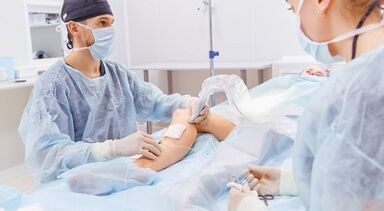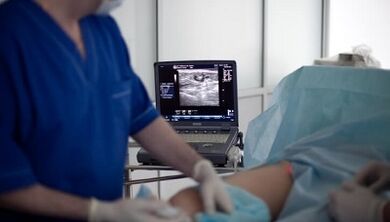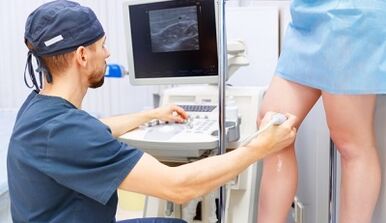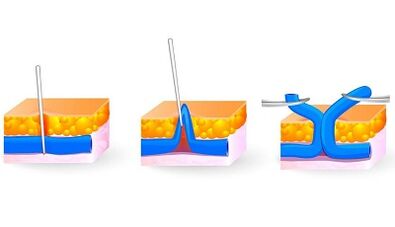
Long decades, surgical treatment of varicose veins leg remains the only radical method of removing this disease and its complications.
Thanks to modern technologies and improve operational techniques, it is really efficient and in therapy and cosmetics, it is done as easy and painless, well-tolerated by patients and does not cause long-term disability.
Indications and contraindications
It is not advisable to do patients with any varicose veins.There are clear indications for work and contraindications in its application.
The surgical treatment of varicose veins of the lower extremities is stated in the following cases.
Medical indications- The spread of a vein of 2-3 degrees, accompanied by complaints and signs of a chronic vein failure:
- Convincing, tense veins under the skin;
- Multiple Varici (nodes) along the amended vessels;
- swelling of affected legs;
- seriousness and pain along the extended veins;
- Convulsions in the calf muscles of the lower leg, when "reduces the leg;
- inflammatory changes in veins - thromboflebitis;
- Trophy skin disorders - dark spots, redness, subcutaneous layer sealing, long-lasting wounds.
Cosmetic indications- Early (first) phase of varicose veins without signs of venous insufficiency, causing only cosmetic defect and aesthetic discomfort in the patient:
- superficially located a little extended and bent veins;
- Vascular "stars," "spider" and reddish-blue small capillaries in the skin of the leg.
It is important to remember that even if there are indications from the operation, it must be rejected if the risk of it exceeds.
Main contraindications for surgical treatment of varicose veins:
- A serious general condition caused by any acute (heart attack, stroke, inflammation) has launched chronic diseases (liver, cordial, pulmonary insufficiency) or patient age.
- Of any acute infectious diseases.
- Conducting treatment for cancer.
- Anemia.
- Uttered increase or decrease in blood coagulation.
- Inflammatory and supporeal processes (results, rash) on the skin of the lower limb, where surgical intervention is planned.
- Pregnancy and early postponiaries.
All contraindications, except for the first, are considered a relative.This means that under special circumstances (acute dangerous conditions caused by varicose veins, thrombophlebitis on thigh) must be performed), one or another scope of surgical treatment.
When an emergency surgery is required
Emergency surgical treatment of varicose leg veins may be required in just one case - with acute ascending thromboflebit.This complication is inflammation within the lumens of large subcutaneous veins, accompanied by the formation of blood clots.

If such a pathological process refers to the thigh, there is a risk of patiff blood clots into a deep venous system.In the case of separating such a clot in the blood, he penetrates the lung vessels and clogs them, which causes threatening life of dangerous disease - pulmonary thromboembolism (lung fibers).
The main manifestations of the growth of thrombophlebitica of the thighs:
- pain with a vein along the inner surface of the thighs;
- redness and increase in skin temperature;
- The seal of the altered area and its sharp pain in palpation.
With the ascending thromboflebitis, the volume of surgical treatment can be represented:
- Cross - dressing and intersection of large subcutaneous veins in the place of mouths in Bedney;
- Removing the changed veins after preliminary overflow.
Goals of surgical intervention
Normally, about 30% of the blood from the lower extremities flows through small subcutaneous venous tributaries, which connect into two central vein trunks - large and small subcutaneous veins.These containers are directly related to deep veins, through which 70% of the blood flow.In the places of such compounds there are valves that pass only from surface veins in deep.
There are also dozens of small veins, which are called perforant, additionally connecting a surface wedding net with a deep.They also have valves that pass the blood in just one way.
The main cause of varicose veins is the failure of the fan, which leads to improper blood release: from deep veins to the surface, which increases the pressure in them and leads to spread and small vessels and central meats.
The main goals for which surgical treatment is focused on varicose veins of the lower extremities:
- Elimination of blood stagnation in modified surface veins of the legs, which will prevent the progress of chronic venous insufficiency and trophic skin disorders.
- Removing deformed vessels and varieties representing a cosmetic disadvantage.
- Elimination of blood release from deep veins in the surface - bay and intersection of perforental (clans) vein, as well as large and small subcutaneous veins in their relationship with deep.
- Prevention of repeated occurrence of varicose veins.
Preparing for surgery
Full preparation for surgical treatment for varicose veins includes:
- General preoperative overview that allows you to assess the patient's health and urine tests, coagulogram, biochemical analysis, blood types and the Republic of Factor, Syphilis tests, lung levels, ECG.
- Special diagnostics that allow you to determine the characteristics of the disease - ultrasound with color mapping on the surface, deep veins and arteries of the lower extremities and labeling the location of insolvent perforent veins.
- The operation is performed on an empty stomach, so you can't eat and drink in the morning on the day of the operation.
- In the morning before surgery, it is necessary to carefully shave all the hair on a painful leg from the groin to the feet.
Treatment of female varicose veins

A separate place in the surgical treatment of female varicose veins of the lower extremities belongs to cosmetic surgery.After such interventions, not only pathologically modified veins, but also postoperative scars on the skin of the leg or are inconspicuous.
To achieve maximum cosmetic effect, surgical operation for varicose veins is performed according to the following methods:
- Laser or radio frequency veins for ablation- Karling of the central devils of large and small subcutaneous veins beneath ultrasound control through punching skin on thigh or foot.
- Stem sclerobler and sclerotherapy-The receipt of large and small subcutaneous veins, as well as all their tributaries, even the least, with special drug scleroccurrent drugs.
With any of the described treatment methods, varicose veins are not removed, they have already been converted from blood vessels in a soft cicatričak fabric.And physical influences (laser rays, radio frequency waves) and chemical compounds (sclerose) destroy the inner layer of veins.Thanks to that, losing lumen, glue and completely lowered blood, turning into a regular bonding (cicatric) tissue.
Therefore, without direct vein removal, all goals are achieved, which are awarded quickly treatment of varicose veins of the lower extremities - changed vessels are eliminated, and the dangerous consequences of venous insufficiency are eliminated in them.
The only limitation of cosmetic surgeries in the treatment of varicose veins in women is possible only something or limited extended veins per 1-2 degrees.During the pregnancy and in the early post perpetration, surgical treatment was contraindicated with the exception of acute situations that require urgent intervention, for example, with an upward thromboflebitis.The operation is limited to the overflow of a large subcutaneous vein at the point of connection with the Fed (window layer).
Types of surgical operation
Consider the most common surgical interventions in the treatment of varicose veins of the lower extremities: laser ablation, endoscopic vein and phlebectomy dissection.
The latter is divided into the following types:
- Classic surgery or complete removal or operation of Trojan-Trendelenburg-Bubko-Narata;
- short removal;
- Mineillebectomy.
Flebectomy
Removal, extraction of veins from the skin is called phlebectomy.This is one of the first methods of surgical treatment of varicose veins of the lower extremities.But even today, phlebectomy is most often performed with phlebology and vascular surgery.There are three modifications and work methods: full, short download, miniflex.
The amount of intervention was presented:
- As a bandage of the trunk of a large subcutaneous vein in the place of his mouth, 2-3 cm on the thigh under the inguinal flap, in thigh, through the cut.
- Its removal throughout the groin to the leg using a special probe through two skin cuts 1-2 cm along the inner surface near the knee and ankle.
- The removal of all varicose veins and small veins through separate small cutting is about 1-2 cm (can be 5-6 to 10-20) with the overflow of insolvent perforate vessels.
- Sewing all the wounds of cosmetic seams.
Classic phlebectomy is the most common allows you to remove varicose veins, but most traumatic among all existing techniques.
Brief removal
With a short skiing, the whole large subcutaneous vein is not removed, but only his fragments, for example, affected by varicose veins, only on thigh or on the lower leg.Healthy segments are not removed.This reduces the trauma of the intervention, but the risk of recurrence of the disease remains.Otherwise, operational operations operations are similar to classical phlebectomy.
Miniflebectomy

The innovative methodology for removing small varicose veins of large subcutaneous veins is called miniflubectomy.
For his implementation, special tools are needed (pointed scalpel, hooks, clamps, blades), with which veins outside pull through the skin skin several millimeters.It is not necessary to sew such skin damage, scars are invisible.
Most often surgeons combine a short or complete removal of a large subcutaneous vein with midiflebectomy.Such a combination surgery combines radicalism and minimal trauma with good cosmetic effect.
Endoscopic dissection of veins
Finding all inferior perforated veins during any phlebectomy is difficult.Endoscopic equipment (video cameras and manipulators) is used for these purposes.Through small cuts in 1-2 cm, they are inserted under the skin in the places of the perhorental vein cluster, which are discovered by ultrasound.
Under the control of the camera, all inferior perforators find, bandage and cross them.During this operation, subcutaneous veins have not been removed.It can be reported independently and in combination with any type of flexopothomy: removal, minicbectomy.
Laser treatment
Laser ablation for varicose veins includes the ignition of the laser beam of large subcutaneous veins throughout its approval.To do this, through the penetration of the skin on the thigh or the end of the ankle in Lumen in the vertic in the catheter all over the entire length.Under the control of ultrasound, the holy is slowly extracted.
Laser beam, which operates on the vein wall, destroys the inner layer.As a result, Vienna falls and stops functioning, which is clearly visible on an ultrasonic monitor.If not only the main venous trunk, but also its tributaries, varicose veins are removed with varicose veins, they are removed in accordance with the Minik method.
Rehabilitation
Regardless of the operational methods of treatment of varicose veins, the renewal of patients in the postoperative period is rapidly happening.The conditions of full rehabilitation depend on the methodology of surgery, the stage of disease and the general condition of the patient.With laser treatment and midifelectomy of initial varicose veins, it is 2-3 weeks, with classic phlebectomy for advanced forms of disease - 1-3 months.
Walking is recommended as soon as possible, provided that the condition is stabilized after anesthesia - after 5-6 hours.If the spine anesthesia is derived, bed rest is recommended within 12 hours.With local anesthesia, the patient can leave the operating room on his feet and he is neither hospitalized in the hospital.The main condition before walking is a bend of the leg with an elastic bandage or put on an individual selected knit compression.
Stay in a hospital from 1-2 to 5-8 days.If the seams were written, they better remove them at 7-8 days during the control inspection from the experts.Within a month after the operation, it is recommended to wear a shinged laundry compression.It is necessary to put it every day before you get out of bed.Compression products are removed at night.After classic phlebectomy with severe varicose veins, it is better to continue compression up to 3 months.
Throughout the month strictly prohibited:
- Sauna and a warm bath;
- Heavy physical activity on the lower limbs;
- Long stay in a stationary position standing or seated.
Possible complications
Most common complications related to varicose vein operations:
- Pain in a managed leg as a result of damage to large nerves.
- Long-lasting swelling of the lower leg and foot.
- Hematomi and bruises on the lower leg and thigh.
- Bleeding from the wound.
- Flebotrombosis - inflammation of deep veins.
- Supervision of postoperative wounds and necrosis (establishment) of the skin around them with the formation of trophic rectors.
- Formation of gross postoperative scars.
Thanks to modern methods and technologies, the surgical treatment of varicose veins is simple, painless and with high efficiency.Compliance with all the recommendations of the postoperative period contributes to the rapid renovation, minimizes the risk of complications and relapse diseases.























